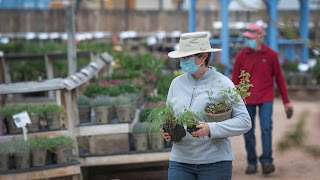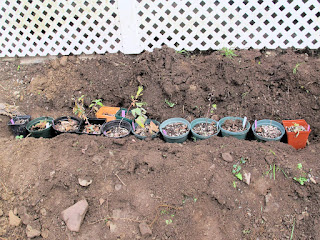Posted by: Alison O'Connor, Larimer County Extension
Don't get me wrong--it's been a hard year. There have been many challenges, new stresses, obstacles, and uncertainty. "Be flexible" has been a good mantra. Despite the bad, there's also been a lot of good. So let's take a moment to reflect on the positives...
People started gardening.
We were stuck at home, looking outside at our landscapes, so people picked up a shovel and got busy. This meant record-breaking seed sales. Baker Creek, a supplier of heirloom seeds, reported over 10,000 orders on one day in late March. In some cases, this meant packing and shipping delays. It also meant that some seeds were completely sold out. For those of us in horticulture, the news was exciting! New gardeners! (And truth be told, it also provided us Extension folk a bit of job security, since we knew these new gardeners would have questions.) The record seed sales also extended to nurseries and greenhouses, who struggled to keep plants in stock due to demand.
 |
| Shoppers at Fort Collins Nursery (Fort Collins, Colo.) (photo courtesy of The Coloradoan) |
Several garden centers reported higher-than-normal Mother's Day sales, with customers swarming to buy hanging baskets, annuals, and summer-blooming bulbs. Signs were posted that said, "New shipments are on their way!" Garden centers responded with curbside pick-up and online ordering. For months, one of the nurseries in Fort Collins had long lines lining the frontage road in front of their store the moment they opened each day. A warm welcome to all of our new gardeners!
Gardeners gave back to their community.
The CSU Extension Grow & Give project provided resources for people to grow produce with the intent of donating some of it back to their communities. Wildly successful (and award-winning!), this project was adopted by 37 Colorado counties. Gardeners donated more than 46,000 pounds of fruits and veggies to local food banks and pantries, as well as churches, community groups, and neighbors.
Farmers' markets were successful
Nationally, farmers' markets were deemed as "essential business", meaning that they were allowed to operate as per health department regulations. The Larimer County Farmers' Market, operated by CSU Extension in Larimer County, scrambled to open their doors in May. Despite numerous regulations and mandates, the market operated successfully for 24 weeks. It even had the highest sales day in its 45-year history in August. Masked customers lined up obediently, six feet apart, to purchase their favorites from dedicated vendors. Hand sanitizer, wash stations, gloves, and masks all became part of the market culture.
 |
| Styria Bakery II at the Larimer County Farmers' Market (photo courtesy of Karen Collins) |
I recently read this heart-warming story that brought tears to my eyes and provided the hope that we're so desperate for. Aaron Moreno, a California first grader whose family was homeless, sold plants to help his family get an apartment. His mom gave him her last $12, which he invested in succulents and sold them for a profit of $4. He took that money and reinvested it into buying more plants. Setting up his table outside a shed, where the family was living, people bought the plants--in droves. Aaron's Garden raised enough money (with the help of GoFundMe) to move his family out of the shed into an apartment. Aaron now has money in the bank and a place to do homework. While he may not stay in horticulture (he wants to be a judge), it's clear that gardening changed his family's life.
 |
| Aaron Moreno of Aaron's Garden (photo courtesy of @aaronsgarden on Instagram) |
Yep. It's been a tough year. But there's still so much good. And if tough times have proven anything before, it's that we'll get through this. Together. Happy Thanksgiving to you all.










